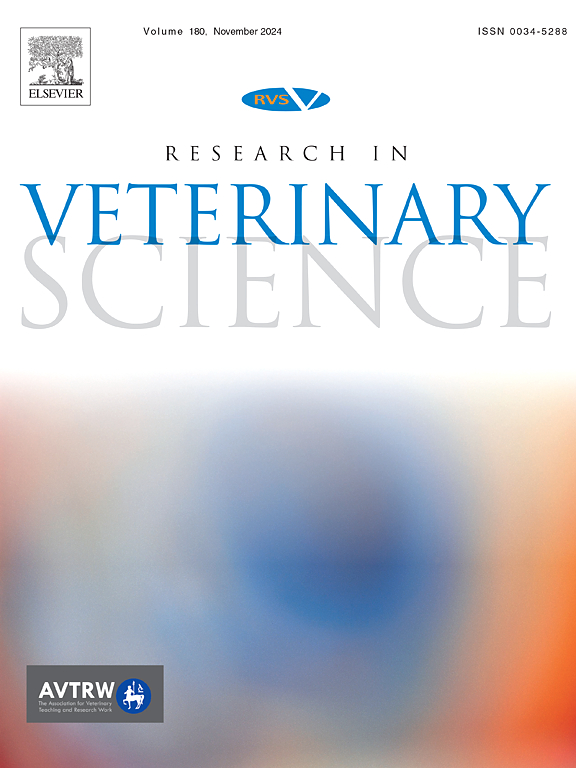Evaluation of Scalibor® deltamethrin collar chronic exposure in dogs
IF 2.2
3区 农林科学
Q1 VETERINARY SCIENCES
引用次数: 0
Abstract
Deltamethrin is a pesticide used worldwide with several applications in the control of nuisance arthropods in homes, agriculture, against ectoparasites in dogs and livestock. Recent studies indicate that deltamethrin can induce cardiotoxicity. Therefore, this study aimed to evaluate the toxicity of deltamethrin in dogs through exposure to commercial collars over 8 months. Twenty healthy dogs were selected, 9 males and 11 females, weighing between 10 and 15 kg and aged between 1 and 8 years, with no history of intentional exposure to pyrethroids. Clinical, cardiological, and laboratory evaluations were performed monthly. The results demonstrate that exposure to deltamethrin 4 % via the dermal route, through a commercial collar, was safe for 8 months, with preserved cardiac electrocontractile function, assessed by electrocardiogram and echocardiogram. In addition, tracking of plasma biochemical markers did not indicate signs of cardiac, renal, or hepatic injury. Although deltamethrin 4 % collars demonstrated an acceptable safety profile regarding cardiovascular and laboratory evaluations, the occurrence of dermatological reactions in 25 % of the animals, which is a significant proportion, highlights the need for careful monitoring of dermatological reactions. Future investigations with different concentrations and longer periods are recommended to achieve a more comprehensive understanding of the long-term effects of deltamethrin, improving its safe application in veterinary medicine and promoting animal and human health.
犬慢性接触Scalibor®溴氰菊酯项圈的评价。
溴氰菊酯是一种世界范围内使用的杀虫剂,用于控制家庭、农业中的有害节肢动物,以及防止狗和牲畜中的体外寄生虫。近年来的研究表明,溴氰菊酯可引起心脏毒性。因此,本研究旨在通过暴露于商业项圈8个月以上来评估溴氰菊酯对狗的毒性。选取了20只健康犬,雄性9只,雌性11只,体重在10至15公斤之间,年龄在1至8岁之间,没有故意接触拟除虫菊酯的历史。每月进行临床、心脏科和实验室评估。通过心电图和超声心动图评估,结果表明,经皮肤途径,通过商业项圈暴露于4%溴氰菊酯8个月是安全的,心脏电收缩功能得以保存。此外,血浆生化标记物的追踪没有显示心脏、肾脏或肝脏损伤的迹象。尽管4%溴氰菊酯在心血管和实验室评估方面显示出可接受的安全性,但在25%的动物中发生了皮肤病反应,这是一个很大的比例,强调了仔细监测皮肤病反应的必要性。建议今后开展不同浓度和较长时间的调查,以更全面地了解溴氰菊酯的长期影响,提高其在兽药中的安全应用,促进动物和人类健康。
本文章由计算机程序翻译,如有差异,请以英文原文为准。
求助全文
约1分钟内获得全文
求助全文
来源期刊

Research in veterinary science
农林科学-兽医学
CiteScore
4.40
自引率
4.20%
发文量
312
审稿时长
75 days
期刊介绍:
Research in Veterinary Science is an International multi-disciplinary journal publishing original articles, reviews and short communications of a high scientific and ethical standard in all aspects of veterinary and biomedical research.
The primary aim of the journal is to inform veterinary and biomedical scientists of significant advances in veterinary and related research through prompt publication and dissemination. Secondly, the journal aims to provide a general multi-disciplinary forum for discussion and debate of news and issues concerning veterinary science. Thirdly, to promote the dissemination of knowledge to a broader range of professions, globally.
High quality papers on all species of animals are considered, particularly those considered to be of high scientific importance and originality, and with interdisciplinary interest. The journal encourages papers providing results that have clear implications for understanding disease pathogenesis and for the development of control measures or treatments, as well as those dealing with a comparative biomedical approach, which represents a substantial improvement to animal and human health.
Studies without a robust scientific hypothesis or that are preliminary, or of weak originality, as well as negative results, are not appropriate for the journal. Furthermore, observational approaches, case studies or field reports lacking an advancement in general knowledge do not fall within the scope of the journal.
 求助内容:
求助内容: 应助结果提醒方式:
应助结果提醒方式:


